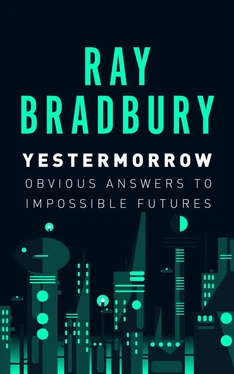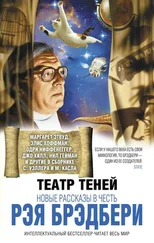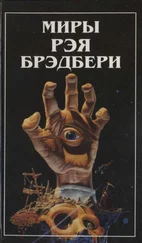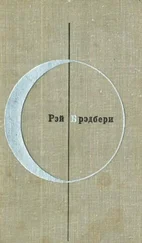“My God!” the common cry will be, “are the great paintings of the world all that immense!?”
Not all, no. Some. Quite a few.
And heretofore unseen, or if seen, melted down to hand-mirror size and trapped in books, beautiful and small, instead of ten times more beautiful and perhaps a hundred times larger than the lives that pass through these galleries to be changed, enroute, forever.
Why bother?
Well, even in this jet-travel time, millions will not fly about the world, millions will still be stay-at-homes in 2001. It will be for them, as it was in the time of Victoria and Albert and their incredible Curators, that we will build our twilight museum. The Queen and her Prince truly cared for the general population, and so shipped home treasures to please the shopkeeper and thrill the barmaid.
Then, too, there will always be the jet-traveler, who will hunger for a large size memory refreshment. Anyone in need of a proper Monet fix, or a Seurat eye-dazzlement can ramble to our just-before-sunrise, just-after-dark-shadow gallery, and watch as a dozen and then a hundred and then a thousand bright images come up in waves, like tides on an amazingly endless shore.
Stroll in our twilight gallery and see twelve portraits for half an hour. Or touch a button, stay for three hours, and see every mind-numbing grotesque painting that Dali ever imagined while driving horizonless highways without his car.
Technical problems?
Plenty.
But we have moved into a high-tech world, where the quality of photography, color slides, projectors and screens should insure us of high-resolution delivery.
Not just another head-on slide show. But a gallery-seeming experience, where you are surrounded on all sides, by the imagination of the artist, a gymnasium where his whole life’s work can perform endlessly for art critic, passionate art lover, or your merest student from first grade to senior high.
Well, there you have it. A garden of ever-changing delights. Or a fountain that runs in colors and changes shapes through noons, mid-afternoons and nights. A gift to all who will never travel. A loving reminder, to those who have, of what they left behind in Florence, in Rome, in Paris, and all across the world.
Can we collect these photographic bouquets and rearrange them and hand them back as celebrations on no particular day for no particular reason, save beauty itself?
Might as well ask if Monet can make the sun climb the cathedral facades at dawn, dazzle the battlements in the late day, and bronze them with a golden flesh as the sun vanishes.
Monet, borrowing from the history before Time cried: “Light!” And there was Light.
Why can’t we do the same?
1987
Symbology of a University
We have all strolled through colleges and noted that the library is here, the art gallery there, the museum next door, and the classrooms and theater just beyond. Often, we found libraries sharing quarters with certain colleges. But if two or three of the above-mentioned environments happen in one building, they are separated in confines that shut out people rather than invite them in.
Imagine, instead, what I call a Yestermorrow architecture, imaginative enough and large enough to enclose everything in a single structure.
And one, I might add, that lures, calls, leads, and pulls you from one area to the next.
Imagine…
An art gallery enclosing
a museum, enclosing
a library, enclosing
a university, enclosing
a theater.
Five concepts,
five environments,
five ways of seeing life.
Each circling,
each rounding the other.
The outer circle, the art galleries, would illustrate all of the metaphors to be found as you move inward.
The second circle would display all the artifacts of our various histories in a museum round.
The third enclosure would be the library.
Followed by the inner round of the classrooms.
And at last, the theater.
Why a theater at our architectural core?
Well, isn’t life one drama topping another? Isn’t everything theater?
Everything, that is, from courting rituals to marriage ceremonies, to office space, to town plaza, to rocket pad at Canaveral?
Try to imagine any human activity that does not finally shape itself into vivid metaphors spoken, acted, taught.
What we have here then is a series of incredible cups, round boxes, a five-shelled wagon train circled to shield us from the night.
Again, stepping through from circle to circle, what would we find?
The paintings, lithographs and watercolors that portray humanity in private encounters or en masse.
Natural life itself as delivered to us by archaeologists and anthropologists from tarpits or Troy ruins.
And then all the massed bricks of the wondrously mysterious library where one can monkey-climb the stacks to Kilimanjaro leopard, Everest snow, or Alpha Centauri immortality.
Giving the onionskin another peel—the university.
Small perhaps, under the circumstances, but containing a dozen rooms where a dozen subjects, relating to the surrounding totality, are delivered forth.
And then at the sounding heart, the voices of dramatic theater, or your special vibrant professor, or your teaching-tool cinema, repeating in yet other forms, the truth collided with on your way around or on your way in.
An architecture, in sum, it seems to me, as marvelous as those rounded self-encircling nautilus shells found along the shores of our seas.
Easy to build? In the mind, yes. With glass, brick, stone, and mortar? Difficult. And expensive.
But if finally blueprinted, built and sent down the ways to ride the mid-oceanic grass of a California university garden, what a place to travel, wander, and stay. What a pomegranate experience. What an incredible womb, finally, in which to grow ideas and rear young and old children.
Will it be built between now and the century’s end? And in the one hundred years beyond, can it be the most imaginative teaching hearth ever built to warm our minds?
I say it can be done.
I wish it to be so.
1988
YES, WE’LL GATHER AT THE RIVER
L.A. Pedestrians, Arise!
We’ve all heard the words to the old and familiar spiritual “Yes, We’ll Gather at the River,” and, indeed, in a few years, if we do not gather at the actual rim, we will put ourselves together near the river. We speak, of course, of the L.A. river, which channels dry wind and warm dust through most of our Southern California year.
And, yes, we will gather, if we plan it well, at a riverbed of now-isolated communities in downtown Los Angeles—those areas being Little Tokyo, Olvera Street, Chinatown, and the intermingled Italian commercial isles.
Created separately by different customs in various years, these proofs of our immigrant past stand but a few hundred yards apart. Yet they might as well be separated by tens of miles for all the mixing or lack of mixing between these towns within a city.
Rarely do the inhabitants of the three or four communities stroll from one to the other. Rarely do tourists, abandoning their cars, ricochet happily from one immigrant duchy to the next.
All that must change.
What is missing at this moment in time? The almost forgotten pedestrian of yesteryear. Who removed his legs and turned off his lights?
We did, by neglect, surely not by plan.
To see what we have done wrong and what can be renovated right, the simplest stroll through London, Paris or Rome will reveal the paucity of our imagination, and the need to rejuvenate curiosity and the delight that is derived from walking mile after mile and relishing the mileage.
Читать дальше











